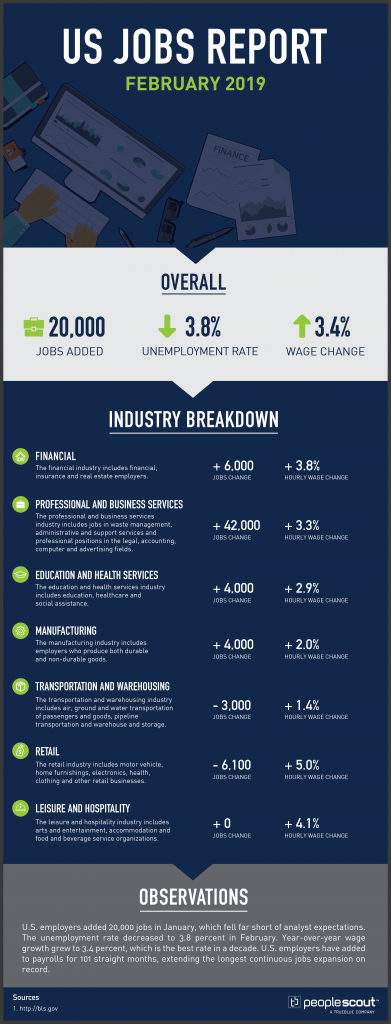The Labor Department released its February jobs report which shows that U.S. employers added 20,000 jobs in February, well below analyst expectations. The unemployment rate decreased to 3.8% last month. Year-over-year wage growth increased to 3.4%, the best rate in a decade. U.S. employers have added to payrolls for 101 straight months, extending the longest continuous jobs expansion on record.

The Numbers
20,000: The economy added 20,000 jobs in February.
3.8%: The unemployment decreased to 3.8%.
3.4%: Wages increased to a rate of 3.4% growth over the last year.
The Good
Despite the low number of new payrolls added, the historic job creation streak continued. The change in total nonfarm payroll employment for December was revised up to +227,000, and the change for January was revised up to +311,000. After revisions, job gains have averaged 186,000 per month over the last three months.
The unemployment rate declined by 0.2 percentage points to 3.8% in February, and the number of unemployed persons decreased by 300,000 to 6.2 million. Among the unemployed, the number of job losers and those who completed temporary jobs (including people on temporary layoff) declined by 225,000.
This decline reflects, at least in part, in part, the return of federal workers who were furloughed in January due to the partial government shutdown. Those workers who were working part-time jobs for economic reasons are now in full-time positions. As one economist put it, “They now have paychecks and don’t need to drive Uber to make ends meet.”
A comprehensive unemployment rate that counts discouraged workers as well as those holding jobs part time for economic reasons, which is often called the “real” unemployment rate, fell to 7.3% in February from 8.1% in January.
The year-over-year wage increase of 3.4% is well above the rate of inflation. The result will likely result in more consumer spending that helps fuel the American economy.
The Bad
February’s report shows the weakest job growth since September 2017. While there are one-time factors such as the partial government shutdown and record cold temperatures in much of the country which may have contributed to the modest growth, it could also be an indicator of a slowdown in the job market in the coming months, the New York Times reports.
“With a single report, the six-month average rate of job growth has fallen to 190,000 from 234,000. That lower number is a better fit with everything else we know about the state of the economy — particularly a 3.8% unemployment rate and lots of anecdotal reports of scarce workers. Businesses can’t add people to the payrolls who don’t exist. Add in the ample evidence that the overall rate of growth is shifting down as trade wars continue to disrupt industries and as the impact of tax cuts fade, and a more modest rate of job creation makes sense. So job growth in the sub-200,000-a-month range seems a lot more plausible for the rest of 2019 — and yet more deceleration is a strong possibility.”
The Unknown
How significant is February’s weak jobs report? Many analysts caution that one report does not provide a clear indicator of long-term trends:
“Mark Hamrick, senior economic analyst at Bankrate.com, said “slowing job growth is to be expected over the coming year, one way or the other,” but blamed much of the February shortfall on a seasonal hiring slowdown in the construction and leisure and hospitality sectors. “It is fodder for a reminder that we cannot assume too much about a single monthly report.”
While the economic significance of the February report remains to be seen, some analysts argue that the overall fundamentals of the American economy remain strong and therefore this weak jobs report could essentially be an outlier:
“One month does not a trend make, and the United States economy remains very robust, especially when compared with sluggish Europe and slowing China. Oil prices are falling, which helps all sectors of the economy except, of course, oil. And while the trade deficit reached a record in 2018, that is a sign of strength not weakness. Exports rose sharply, but imports rose even more, thanks to the booming American economy. And, by definition, capital inflows must offset trade deficits, so a lot of foreigners think the United States is a great place to invest.”
Having been surprised by the details of February’s report, those with a stake in the U.S. and world economy may be anticipating the results of next month’s report with an eagerness they have not felt in years.

![[Webinar] Smart Hiring in the AI Age: What UK Candidates Are Really Doing in 2025](https://www.peoplescout.com/wp-content/uploads/2025/05/AI-enable-applicant-report-320x320.jpg)
